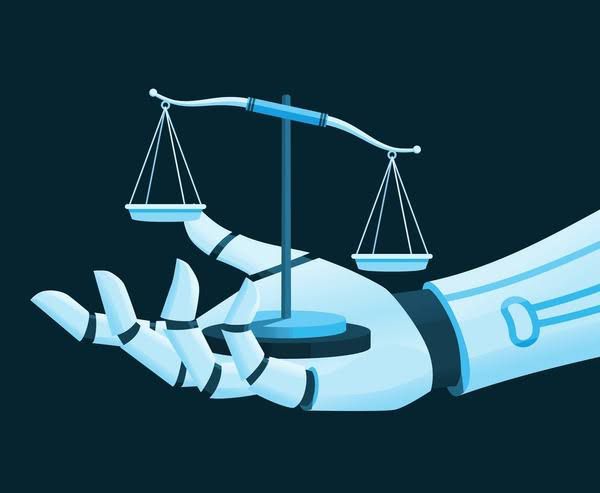Author: Yashijeet Gond, City Academy Law College
To the Point
Artificial Intelligence (AI) is catalyzing a significant transformation in India’s judicial and law enforcement systems, boosting efficiency, accessibility, and decision making. By incorporating AI into judicial functions, case management, legal research, and law enforcement, India is optimizing operations, minimizing delays, and making justice more available to everyone. The Judicial system is confronted with enduring issues such as overloaded case dockets, language challenges, and the requirement for digital upgrades.
Technologies powered by AI- such as Machine Learning (ML), Natural Language Processing (NLP), Optical Character Recognition (OCR), and Predictive Analytics- are being utilized to automate administrative duties, enhance case tracking, and improve crime prevention efforts.
Projects like the e-Courts, AI- based legal translation, predictive policing, and legal chat-bots driven by AI are transforming the legal framework, making processes quicker, smarter, and more transparent. Although the implementation of AI poses challenges, especially concerning data security, ethical regulation, and legal frameworks, its capacity to fortify India’s justice system is unmatched. This article delves into the revolutionary influence of AI in India’s judiciary and law enforcement, emphasizing its applications, effects, and future possibilities in fostering a more efficient, transparent, and citizen-focused justice system.
Major AI System uses in India
E-Courts Services: this is a unified case management system utilized by several courts throughout India. It offers a variety of services, such as online case submission, monitoring case statutes, and managing documents.
Case Information and Management System (CIMS): CIMS is an AI-driven case management platform used by the Supreme Court of India as well as various High Court in the country. It aids in automating case management tasks, including filling case management, and tracking cases.
Integrated Decision Support System (IDSS): IDSS is an AI-empowered system that supplies judges with pertinent legal resources, such as case laws and precedents, to assist them in making informed rulings.
SUPACE: The Supreme Court Portal for Assistance in Courts Efficiency (SUPACE) is an AI-integrated platform designed by the Supreme Court of India to enhance the efficiency of court processes. The platform employs advanced analytics and machine learning to provide judges with relevant legal information and support their decision-making.
SUVAS: The Supreme Court Vidhik Anuvaad Software (SUVAS) is an AI-driven translation tool created by the SC of India to assist judges and lawyers in translating legal documents between English and regional languages.
Abstract
Artificial Intelligent (AI) has become a prevalent concept across various fields, including the legal sector. AI has the capability to transform how the judiciary operates and delivers justice. The integration of AI within the legal framework promises to improve decision-making for judges, attorneys, and other legal professionals, while also offering the public more efficient, streamlined, and economical services. The adoption of AI in the legal realm brings numerous advantages, such as automation in tasks like document review, legal research, contract evaluation, case forecasting, and judicial decision-making. By mechanizing tedious and error-prone tasks, AI can help reduce the workload involved in these demanding activities. As a result, courts worldwide have started to adopt AI technology to enhance the justice process. However, the application of AI in the judiciary also raises several ethical concerns. It is essential to tackle these ethical concerns effectively to ensure the responsible and widespread application of AI systems.This article outlines the key ethical dilemmas associated with utilizing AI in the judiciary and offers suggestions for effectively resolving these challenges.
Case Laws
Jaswinder Singh vs State of Punjab-
The Punjab and Haryana High Court rejected a bail petition due to allegations from the prosecution that the petitioner was involved in a brutal fatal assault. The presiding judge requested input from ChatGPT to gain a wider perspective on the granting of bail when cruelty is involved. However, it is important to note that this reference to ChatGPT does not express an opinion on the case’s merits and trial court will not consider these comments. The reference was solely intended to provide a roader understanding of bail jurisprudence when cruelty is a factor.
Conclusion
Artificial Intelligence is revolutionizing the judiciary and law enforcement in India by improving case management, legal research, crime prevention, and accessibility to various languages. Tools powered by AI, such as predictive analytics , automated documentation, chatbots, and advanced policing systems, are enhancing efficiency and governance in the legal framework. Nevertheless, the adoption of AI must be done responsibly, requiring robust data security, legal reforms, and transparency to ensure it complements human judgement rather than replacing it in judicial proceedings. The evolution of AI in law and justice will be influenced by AI- enhanced legal research, blockchain-secured case files, judicial transparency facilitated by AI analytics, and strengthed cybersecurity in law enforcement.
FAQS
What is the use of AI in the Judiciary?
Enhancing the efficiency of the judiciary: There is an opportunity to assist judges in conducting trials more quickly and effectively, which would help reduce the accumulation of cases.
Developing Judge Analytics: By training the application on an extensive historical dataset of precedents. It can pinpoint key aspects pertinent to specific contracts. This will facilitate the analysis of thousands of prior cases and generate a Judge Analytics framework.
What is Machine Learning (ML)?
ML represents a form of AI that enables software applications to improve more their accuracy in predicting outcomes without being explicitly programmed. It algorithms use historical data as input to forecast new output values.
What are the examples of use of AI in Judiciary?
Virtual Hearing, SUVAS (Supreme Court Vidhik Anuvaad Software) and SUPACE (Supreme Court Portal for Assistance in Court Efficiency) are some of the examples of usage of AI in Judiciary.
What are the ethical challenges in AI adoption in Indian Judiciary and Law Enforcement?
Precision: AI technologies are not without flaws, as tech companies themselves recognize. For eg, Open AI states in its terms of service that the output may not always be correct and should not be relied upon as the exclusive source of truth or professional counsel.
AI System Bias and Risk: The intrinsic biases present in AI systems present serious dangers, especially in sectors like crime prediction and mapping.





